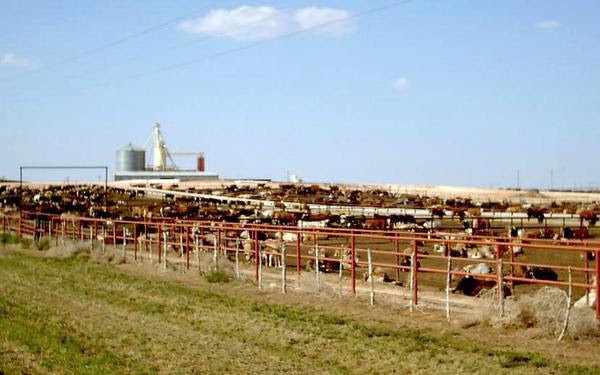
Farm Raised vs Grass Fed Protein

There are a few reasons why:
-
Grass-Fed protein has higher amino acid protein absorption
-
Grass-Fed protein does not contain antibiotics
-
Grass-Fed protein is better for the environment
It is difficult to argue against Grass-Fed.
In fact, Grass-Fed is how cows are supposed to be fed.
For tens of thousands of years, cows have consumed a Grass-Fed diet.
This is both the more humane and more nutritious way to feed cattle.

Lewter Feed Yard in Lubbock Texas is the first large feedlot on the Great Plains
Beginning in 1955 at the Lewter Feed Yard in Lubbock Texas, large Feedlots began and cows were put on a regime and a schedule to gain the most amount of weight in the shortest amount of time.
In doing so, cows were fed a diet that consisted of milo (millet grain) , some silage (grass), mineral salt, calcium, phosphorus and the new growth hormone DES, diethylstilbestrol.
Growth Hormone DES would later be banned as a cancer-causing agent.

Chickens in nature eat - insects, grass, earthworms.
Chickens in feedlots are given pellets consisting of grains and soybean oil meal.
This is designed intentionally to increase their egg production and body weight.
Once again, grains and fats can enlarge a chicken faster and cheaper than a natural-based diet.
However, the feedlot farm diet consisting of grains and soybean oil meal often causes both food intolerances and inflammation for the chicken as they do cows and humans.


The problem soon became that farm-fed animals in feedlots develop gastrointestinal problems, GERD, and acid reflux.
In fact, many of the same problems that humans develop when eating grains.
Therefore antibiotics such as penicillin are needed to give the cows, chicken, turkeys etc to keep them alive and able to continue to feed to gain weight.
In fact, this is eerily similar to when humans seek help from their doctors for the same types of issues.
Most of it can be traced back to the high inflammatory process of grains.

There are a few reasons why this is important form a nutritional aspect:
- Free range, cage free, grass fed and wild caught protein is universally higher in quality protein, good omega 3 fats and a richer source of vitamins, minerals and fiber.
- In addition, it's more important what humans eat directly (grains, corn, soybean oil) that causes the myriad of health problems across ALL species.
Here is a list of proteins and their relative digestibility and absorbability in descending order:
- Whey Protein – Whey is the most bioavailable source of protein.
- Egg Whites – If you’re lactose intolerant and whey protein disagrees with you, egg whites are a great alternative.
- Fish – Oily fish are often higher in unsaturated fat and rich in omega fatty acids which are hugely beneficial for cardiovascular health.
- Red Meat – Although red meat is slightly lower in terms of bioavailability, it is rich in other areas. For example, red meat is high in iron, zinc and vitamin B12 and they often contain a good amount of healthy fats.
- Poultry – Chicken is next on the list on the protein bioavailability scale. Chicken delivers a high amount of protein with very little carbs or additional fats.

Whey protein sourced from grass-fed cows is also higher in immune factors:
-
Immunoglobulins
-
Lactoferrin
-
Serum Albumin
Than whey protein sourced from non-grass fed cows.
This is important because it is needed for immune system strength and support.
In fact, it has many proposed biological functions, including:
-
Antibacterial
-
Anti-inflammatory activities
-
Defense against gastrointestinal infections

100% Pur Zealand Grass-Fed Whey Protein Powder and why we are so proud of it:
-
Highest quality Bioavailable grass-fed protein
-
Highest quality natural ingredients
-
Sourced from New Zealand cows that graze on all-natural, pesticide-free farmlands within a country that upholds the strictest quality controls
-
Free from growth hormone and antibiotics
-
Whey protein derived from grass-fed cows has a higher protein concentration, has up to 5x higher CLA, and has more Vitamin A & E, beta-Carotene, and Omega-3, when compared to grain-fed cows.**

This product is free of:
-
High fructose corn syrup
-
Dangerous artificial sweeteners
-
GMO ingredients
-
Non-dairy creamer
-
Soy, grain or gluten
-
Growth Hormone
-
Sucralose
It is sweetened modestly with all-natural Stevia – and always delicious, pure, effective and natural!
Keto-Friendly, Paleo-Friendly, Mediterranean friendly, low carb friendly.

